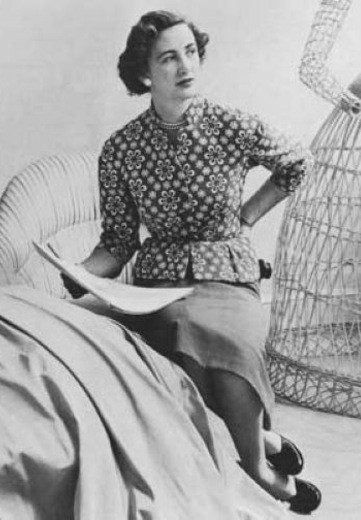
Sybil Connolly
About
Sybil Connolly was born in 1921 in Wales but her father was from Ireland. In 1938, she served an apprenticeship with Bradleys, the dressmakers in Connolly began her fashion apprenticeship while in her teens, going to work for a London dressmaker to study dress design. Her most notable experience during her two-year tenure there was holding pins for Queen Mary's fittings at Buckingham Palace and noting the immense care being taken to design dresses that softened and complemented the dowager Queen's advanced age. Her apprenticeship at Bradley's was cut short by the outbreak of war, and she returned to Ireland. In 1940, she continued her apprenticeship at Richard Alan, which was at the time Dublin's premiere fashion house. At the age of 22, Connolly became director at Richard Alan and proceeded to build the store's couture department. In 1950 she designed a small collection that sold quite well, and her career as a designer began.
In 1953 when Ireland staged it's first international dress show, Sybil Connolly was the star.
Connolly became extremely successful and well-known in Ireland, the USA and later also in Australia and promoted the use of Irish linen, wool, tweed and lace. She appeared on the cover of LIFE magazine, dressed a series of aristocratic figures and became a friend of Jacqueline Kennedy. When Jacqueline Kennedy visited Ireland in July 1967, she visited Connolly and wore one of her linen dresses in an official White House portrait.
In 1957, she parted with Richard Alan and established her own fashion house. She attracted a great deal of attention with her method of hand-pleating fine linen which she made up into delicate blouses and dresses.
She also developed an international reputation as an interior designer and designed crystal and pottery for Tiffany and Company.
In her latter years, she catered only for a small group of loyal clients. She also spent her retirement years on writing books on Irish crafts, homes and gardens.
She died in 1998 at the age of 77.
The Look
She specialized in adapting traditional textiles such as Irish crochet, Carrickmacross lace and Donegal tweeds, into fashion garments. Throughout the 50's and 60's, Connolly helped popularize handwoven woolens, tweeds and mohairs into fashion fabrics. Connolly's design philosophy was in keeping with that of Hubert de Givenchy, whose work was a source of inspiration for her. Elegance without sacrificing comfort, the finest craftsmanship, and attention to detail were the hallmarks of her work. She felt that a dress should show a woman's curves, saying, "I must see movement in a dress. A woman's body is inside. It breathes. It moves." Her other major sources of inspiration were nature and the traditional fabrics and everyday clothing of the Irish. Working in Donegal tweeds, Eliot's poplin, Carrickmacross lace, bainin (a thin, handwoven wool) and Irish linen, she created collections based on the simple slim lines of riding habits, and utilized the hooded cloaks, scarlet flannel petticoats, crocheted blouses, and black Connemars shawls of Irish traditional dress. She also designed evening dresses with ruffled tops, a coming-out gown made entirely of men's linen handkerchiefs, and handkerchief linen nightgowns embroidered with flowers and hand-sewn with tiny tucks, which were a favorite of Jacqueline Kennedy's. Throughout her career, Connolly sought out and utilized the traditional crafts and artistry of her native land: Donegal embroidery, handwoven lace, and iridescent Donegal tweeds. She commissioned the nuns of Clones Convent to make lace for her and found inspiration in the simple lines of a Carmelite nun's habit. Connolly brought echoes of Irish daily life into vogue among the best dressed of the rich and famous. Indeed, Connolly was herself often included on American best-dressed lists. The invention of a unique linen fabric is considered one of Connolly's greatest achievements. Using nine yards of handkerchief linen backed by taffeta to make one yard of hand-pleated dress material, she created an uncreasable, uncrushable linen, which she then custom-dyed in rich colors and fitted into lovely ball gowns. The gowns were so resistant to the ravishments of time that they were an investment lasting generations, handed down from mother to daughter to granddaughter. Jacqueline Kennedy wore a skirt of Connolly's pleated linen when she was painted by Aaron Shickler for a portrait that hangs in the White House. Throughout the 1950s and early 1960s, Connolly enjoyed popularity on both sides of the Atlantic. In the 1970s she continued to bring small collections to New York. She would show them at the Fifth Avenue apartment of a friend, gather orders for custom designs, and take them back to be made up in her Dublin workshops. But the trends of fashion in those years were not to her taste, and she had no interest in following them. She was known to comment that she couldn't understand why the young people of the time were so set on making themselves look "awful." The skirts were too short, the lines were not right, and trousers were "only for riding."